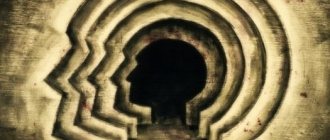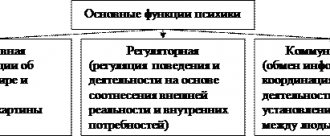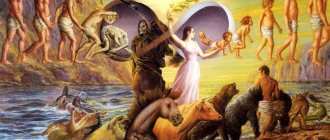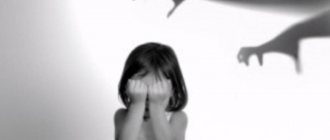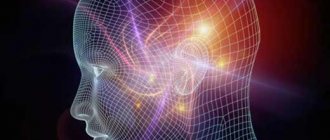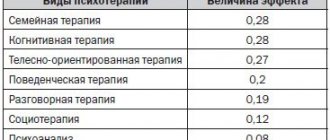In a narrow sense, consciousness is considered as the highest form of the psyche, and the psyche itself is considered as the level of the unconscious. Unconscious processes are not realized by the person himself. The area of the unconscious includes various phenomena, for example, dreams, responses, unconscious behavior, etc.
Psychology explains the emergence of human consciousness by the social way of being of people and work activity.
Information entering the brain, in the process of displaying reality, is consciously processed according to the goals, objectives, and experience of the individual. Depending on the level of knowledge of the individual, scientific worldview, ideological and moral beliefs, the level of development of consciousness among people is different.
Consciousness has its characteristic features and structural components.
Features and structural components of consciousness
Consciousness as the highest form of mental reflection of reality has its own characteristics and structural components:
- Knowledge about nature, society and the surrounding reality in general. The knowledge and experience of an individual, the level of their assimilation are directly related to the level of consciousness. The need for knowledge developed during the entire socio-historical development of people and was the motive for cognitive activity;
- Distinguishing between the subject “I” and the object “I”, identifying oneself as a subject of cognition in the objective world. In relation to contrasting oneself as a person with another objective world, self-knowledge is. It has become the basis for self-awareness or awareness of one’s own physical, moral and psychological qualities;
- This side of consciousness as determination, planning one’s activities and behavior, guessing results, manifests itself in self-control and adjustment of one’s own actions, if necessary;
- The individual’s attitude towards himself, the people around him, and objective reality is manifested in assessment and self-criticism, where the emotional-volitional sphere of the personality plays an important role.
A person becomes a subject of education thanks to consciousness, self-knowledge and self-awareness; only in this case does he set educational goals for himself and achieve the results he needs.
A person's self-awareness manifests itself:
- In self-observation;
- In a critical attitude towards oneself;
- In assessing both your positive and negative qualities;
- In self-control;
- Responsible for actions taken.
Consciousness and activity of the individual always appear in unity, which is manifested in the purposeful activity of a person, in a variety of cognitive, emotional, volitional reactions, attitudes towards other people and oneself.
An important advantage of consciousness is that it relies on speech, thanks to which (external and internal) consciousness is capable of organizing complex activities. A person and his environment interact as an integral organism, which is ensured by the cerebral cortex.
Lecture 2. Psyche and consciousness
Goal: to form students’ knowledge about the development and structure of the human psyche.
Plan:
1. The concept of the psyche.
2. The main stages of mental development.
3. Structure of the human psyche
Basic concepts: psyche, intellectual behavior, skills, mental processes, mental state.
The concept of the psyche.
Etymologically, the word "psyche" ( Greek
.
soul) has a dual meaning. One meaning carries the semantic load of the essence of a thing. The psyche is an entity where the externality and diversity of nature gathers into its unity, it is a virtual compression of nature, it is a reflection of the objective world in its connections and relationships .
Mental reflection is not a mirror, mechanically passive copying of the world (like a mirror or a camera), it is associated with a search, a choice; in mental reflection, incoming information is subjected to specific processing, i.e. mental reflection is an active reflection of the world in connection with some necessity, with needs, it is a subjective selective reflection of the objective world, since it always belongs to the subject, does not exist outside the subject, depends on subjective characteristics. The psyche is a “subjective image of the objective world .
The psyche cannot be reduced simply to the nervous system. Mental properties are the result of the neurophysiological activity of the brain, but they contain the characteristics of external objects, and not the internal physiological processes through which the mental arises. Signal transformations taking place in the brain are perceived by a person as events taking place outside him, in external space and the world. The brain secretes psyche, thought, just as the liver secretes bile. The disadvantage of this theory is that they identify the psyche with nervous processes and do not see the qualitative differences between them.
Mental phenomena are correlated not with a separate neurophysiological process, but with organized sets of such processes, i.e. psyche is a systemic quality of the brain , realized through multi-level functional systems of the brain that are formed in a person in the process of life and his mastery of historically established forms of activity and experience of mankind through his own active activity. Thus, specifically human qualities (consciousness, speech, work, etc.), the human psyche are formed in a person only during his lifetime, in the process of assimilating the culture created by previous generations . Thus, the human psyche includes at least three components: the external world , nature, its reflection - full-fledged brain activity - interaction with people, active transmission of human culture and human abilities to new generations .
Mental reflection is characterized by a number of features:
it makes it possible to correctly reflect the surrounding reality, and the correctness of the reflection is confirmed by practice;
the mental image itself is formed in the process of active human activity;
mental reflection deepens and improves;
ensures the appropriateness of behavior and activity;
refracted through a person’s individuality;
is anticipatory.
2. The main stages of mental development
The development of the psyche in animals goes through a number of stages.
At the stage of elementary sensitivity, the animal reacts only to individual properties of objects in the external world and its behavior is determined by innate instincts (feeding, self-preservation, reproduction, etc.). At the stage of objective perception, reflection of reality is carried out in the form of holistic images of objects and the animal is able to learn, individually acquired behavioral skills appear.
Stage III of intelligence is characterized by the animal’s ability to reflect interdisciplinary connections, to reflect the situation as a whole; as a result, the animal is able to bypass obstacles and “invent” new ways to solve two-phase problems that require preliminary preparatory actions for their solution. The intellectual behavior of animals does not go beyond the scope of biological needs and operates only within the limits of a visual situation.
The human psyche is a qualitatively higher level than the psyche of animals (Homo sapiens - reasonable man). Consciousness and the human mind developed in the process of labor activity, which arises out of necessity, the implementation of joint actions to obtain food during a sharp change in the living conditions of primitive man. And although the specific biological and morphological characteristics of humans have been stable for 40 thousand years, the development of the human psyche occurred in the process of labor activity. Thus, the material, spiritual culture of humanity is an objective form of embodiment of the achievements of the mental development of humanity.
In the process of historical development of society, a person changes the ways and techniques of his behavior, transforms natural inclinations and functions into higher mental functions - specifically human, socio-historically conditioned forms of memory, thinking, perception (logical memory, abstract logical thinking), mediated by the use of auxiliary means , speech signs created in the process of historical development. The unity of higher mental functions forms consciousness .
3. Structure of the human psyche
The psyche is complex and diverse in its manifestations. Usually there are three large groups of mental phenomena, namely:
1) mental processes, 2) mental states, 3) mental properties.
Mental processes are a dynamic reflection of reality in various forms of mental phenomena.
A mental process is the course of a mental phenomenon that has a beginning, development and end, manifesting itself in the form of a reaction. It must be borne in mind that the end of a mental process is closely related to the beginning of a new process. Hence the continuity of mental activity in a person’s waking state.
Mental processes are caused both by external influences and by stimulation of the nervous system coming from the internal environment of the body.
All mental processes are divided into cognitive
– these include sensations and perceptions, ideas and memory, thinking and imagination;
emotional
– active and passive experiences;
volitional
– decision, execution, volitional effort; etc.
Mental processes ensure the formation of knowledge and the primary regulation of human behavior and activity.
In complex mental activity, various processes are connected and form a single stream of consciousness, providing an adequate reflection of reality and the implementation of various types of activities. Mental processes occur with varying speed and intensity depending on the characteristics of external influences and personality states.
A mental state should be understood as a relatively stable level of mental activity that has been determined at a given time, which manifests itself in increased or decreased activity of the individual..
Every person experiences different mental states every day. In one mental state, mental or physical work is easy and productive, in another it is difficult and ineffective.
Mental states are of a reflex nature: they arise under the influence of the situation, physiological factors, progress of work, time and verbal influences (praise, blame, etc.).
The most studied are: 1) general mental state, for example attention, manifested at the level of active concentration or absent-mindedness, 2) emotional states, or moods (cheerful, enthusiastic, sad, sorrowful, angry, irritable, etc.). There are interesting studies about a special, creative state of personality, which is called inspiration.
The highest and most stable regulators of mental activity are personality traits.
Mental properties of a person should be understood as stable formations that provide a certain qualitative and quantitative level of activity and behavior typical for a given person.
Each mental property is formed gradually in the process of reflection and is consolidated in practice. It is therefore the result of reflective and practical activity.
Personality properties are diverse, and they need to be classified in accordance with the grouping of mental processes on the basis of which they are formed. This means that we can distinguish the properties of intellectual, or cognitive, volitional and emotional activity of a person. As an example, let us give some intellectual properties - observation, flexibility of mind; strong-willed – determination, perseverance; emotional – sensitivity, tenderness, passion, affectivity, etc.
Mental properties do not exist together, they are synthesized and form complex structural formations of the personality, which must include:
1) a person’s life position (a system of needs, interests, beliefs, ideals that determines a person’s selectivity and level of activity); 2) temperament (a system of natural personality traits - mobility, balance of behavior and activity tone - characterizing the dynamic side of behavior); 3) abilities (a system of intellectual-volitional and emotional properties that determine the creative capabilities of an individual) and, finally, 4) character as a system of relationships and modes of behavior.
Tasks for SRS:
Make a diagram on the topic
Table in a notebook. Compiling a table of personalities “50 great psychologists.”
Practical lesson No. 2
Plan:
1. Explain the essence of the concept of “psyche”.
2. What is “irritability”, “sensitivity”, “sensation”?
3. Explain the essence of the concept of “consciousness”.
4. What do you know about the main stages of mental development?
Literature:
1. Stolyarenko L.D. Fundamentals of psychology Rostov n/d, 2005.-672 pp. (electronic version).
2. Maklakov A.G. General psychology: Textbook for universities.-St. Petersburg: Peter, 2004.-583 (electronic version)
3. Gippenreiter Yu.B. Introduction to general psychology. -M., 1988 (electronic version).
Previous3Next
Properties of consciousness
There are several basic psychological properties in the human mind:
- Consciousness is characterized by activity. In the process of practical, transformative activity, a person reflects the external world, therefore consciousness is also characterized as a spiritual activity aimed at an active, creative transformation of reality. The activity of consciousness will also be characteristic of social consciousness, for example, progressive ideas that, having mastered the masses, become “material force”;
- Intentionality of the subject's consciousness. In other words, this is a focus on any object, not necessarily on the object of the material world or any specific object. This may be the awareness of some fact, thought at the moment of communication with another subject;
- Consciousness is characterized by constant reflection or a process of continuous introspection in the subject;
- Motivational-value nature of consciousness. This means that a real subject always strives for some goal, even if the goal is the absence of a goal;
- Integrity of consciousness. The general holistic consciousness includes the unconscious, subconscious, conscious, superconscious. All these components are inextricably linked and simultaneously manifest themselves to varying degrees, which depends on the specific mental activity;
- The generalization and abstraction of consciousness manifests itself when it operates with non-real objects and phenomena of the surrounding world;
- Selectivity of consciousness or its focus only on a specific object, and not on the whole world as a whole;
- The dynamism of consciousness or its changeability and ability for continuous development;
- Distortion of consciousness, which manifests itself in the fact that consciousness always reflects reality in a distorted form;
- The uniqueness and individuality of consciousness lies in the fact that the consciousness of each individual person is different from the consciousness of other people.
Consciousness arises only in real, living, thinking subjects and belongs to the realm of the ideal, because images, sensations, and meanings cannot be considered as material objects.
Consciousness and unconsciousness
A state of awareness is a state of a person in which he is able to clearly see and comprehend everything that is happening around him and what is happening directly to him, is able to control his actions and monitor the development of events around him.
The unconscious is uncontrolled, unconscious actions and special mental manifestations. These are two different poles of the psyche, but they are in connection and interaction.
Psychoanalysis was the first in psychology to study individual consciousness and the unconscious, their relationship and how they manifest themselves in behavior. According to this school of thought, a person’s awareness is just no more than one tenth of the psyche. The majority is made up of the unconscious, in which instincts, desires, emotions, fears are stored; they are always with a person, but only sometimes they appear and at that moment control the person.
Consciousness is synonymous with awareness and this term will also be used. So, the conscious is that which is controlled by a person, the unconscious is that which cannot be controlled, only it itself is capable of influencing a person. Insights, dreams, associations, reflexes, instincts - appear without our will, also intuition, inspiration, creativity, impressions, memories, obsessive thoughts, slips of the tongue, slips of the tongue, illnesses, pains, impulses - manifestations of the unconscious, sometimes some of them can appear completely inopportune moment or if the person does not expect it at all.
Thus, there is a connection between the unconscious and the conscious, and today no one dares to refute it. Both the conscious and the unconscious are intertwined in a person and influence both him and each other. The unconscious sphere can open up to a person, which establishes what internal motivations and forces drive a person, his thoughts and actions, outside of consciousness.
Guided by this knowledge, you can greatly improve your life, learn to trust your intuition, become open to creativity, work on your fears, open to insights, listen to your inner voice, and work through repressed desires. All this requires a reserve of strength and desire, but then in order to fully understand yourself, develop, achieve goals, get rid of complexes, you need to engage in introspection and deep self-knowledge.
The unconscious relieves the mind of unnecessary stress and protects against information overload. It contains negative experiences, fears, information traumatic to the psyche and, thanks to this, protects a person from psychological stress and breakdowns. Without such a mechanism, people would not be able to withstand all the pressures from the outside world. Thanks to liberation from negative experiences or outdated unnecessary information, a person is able to fully realize himself.
Protection of a person’s consciousness is manifested in freeing him from constant control over the actions that he carries out every day. Actions such as brushing teeth, using appliances, riding a bicycle, and many others become automatic and do not require thinking about the actions. Also, an adult does not notice how he makes words from letters when he reads, and does not think about what actions he needs to perform in order to walk. In the same way, actions become automatic in professions.
Because some information passes into the unconscious area, much more space is freed up for assimilation of new information, and the mind more easily concentrates on new important tasks. But we must not forget that even what has gone into the unconscious does not disappear without a trace, it is stored, and under the influence of some stimulus it is able to break out, because, in any case, it is part of a person.
The conscious and unconscious psyches are of equal importance to people, and the functionality of either of them cannot be underestimated.
Types of human consciousness
Human consciousness continues to develop along with the development of civilization and is accelerated by the rapid pace of scientific, technological and cultural progress. The following types are distinguished:
- Everyday consciousness. It is formed first among its other types and arises during interaction with things, is fixed in language in the form of the first concepts;
- Project consciousness. The task of this type of consciousness is to cover a range of problems that are associated with the design and implementation of specific goals of activity;
- Scientific consciousness, as a rule, is based on scientific concepts, concepts, models. It explores the relationships between objects, rather than their individual properties;
- Aesthetic consciousness is associated with the process of emotional perception of the surrounding world;
- Ethical consciousness determines the moral attitudes of an individual.
Unlike other types of consciousness, the degree of development of ethical or moral consciousness is assessed by the person himself with great difficulty.
